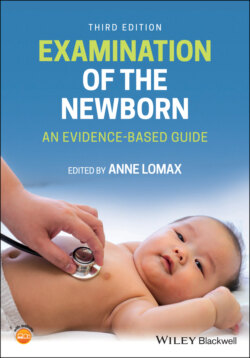Читать книгу Examination of the Newborn - Группа авторов - Страница 28
Intrapartum history
ОглавлениеThe intrapartum history is important in terms of identifying risk factors for the newborn. If resuscitation of the newborn was required, note the level of support given and time to response. It is also important to note if the newborn required admission to the neonatal unit for ongoing observation.
Taking note of the mode of delivery is important because this may impact upon the health of the newborn. If shoulder dystocia presented during the second stage, the newborn must be thoroughly examined by a senior paediatrician for evidence of a brachial plexus injury, a clavicle fracture or sternomastoid muscle injury. An examination in the immediate post‐delivery period by a paediatrician should be part of the maternity service local shoulder dystocia management guideline.
Breech presentation carries a strong correlative risk of developmental dysplasia of the hip (DDH) and is therefore a national NHS NIPE Screening Programme risk factor (PHE 2018a, 2020c). Breech presentation at birth irrespective of mode of delivery, or clinically diagnosed in pregnancy after 36 weeks gestation, or if external cephalic version performed for breech presentation irrespective of gestational age at delivery requires referral of the newborn for ultrasound examination of the hips in line with the national NIPE standards (PHE 2018a, 2020c).
TABLE 1.2 Maternal medical records: summarised alert indicators.
| Maternal medical records: alert indicators |
| Ultrasound scans: |
| PolyhydramniosOligohydramniosDilated renal pelvesIntrauterine growth restrictionSuspected chromosomal or syndromic aberrationsOther significant ultrasound screening findingsCongenital heart defect |
| Abnormal combined or quadruple test result |
| HIV positive serology status |
| Hepatitis B and C |
| Haemoglobinopathy |
| Maternal antibodies |
| Maternal pyrexia in labour |
| Prolonged fetal tachycardia |
| Pre‐labour prolonged rupture of membranes |
| Meconium stained liquor |
| Maternal group B streptococcal infection Breech presentation |
| Maternal disease state: type 1 and type 2 diabetes, autoimmune disorders, e.g. systemic lupus erythematosus |
| Maternal substance use |
| Maternal alcohol dependency Thrombocytopenia |
A precipitate delivery may cause facial congestion that can be misdiagnosed as cyanosis. An instrumental delivery may result in the newborn suffering a degree of head trauma, such as bruising, which may require analgesia and can increase the risk of hyperbilirubinaemia (see Table 1.2 and Chapter 3).
Meconium stained liquor (MSL) can be problematic for a minority of newborns and therefore must be noted from the delivery summary. The presence of MSL is associated with an increased mortality and morbidity, accounting for 2% of perinatal deaths (NICE 2017). It is relatively common with an occurrence of 15–20% in term pregnancies (NICE 2017). Although meconium aspiration syndrome is relatively rare, some of these infants may seem well at delivery but rapidly develop signs of respiratory compromise as a result of aspiration. The National Institute for Health and Care Excellence (NICE) (2017) advocates close observation of the newborn with MSL present at delivery in the immediate postnatal period.
